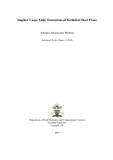JavaScript is disabled for your browser. Some features of this site may not work without it.
| dc.contributor.advisor | Drikakis, Dimitris | |
| dc.contributor.advisor | Shapiro, Evgeniy | |
| dc.contributor.author | Mylonas, Antonios Athanassios | |
| dc.date.accessioned | 2011-07-15T15:31:22Z | |
| dc.date.available | 2011-07-15T15:31:22Z | |
| dc.date.issued | 2010-04 | |
| dc.identifier.uri | http://dspace.lib.cranfield.ac.uk/handle/1826/5700 | |
| dc.description.abstract | Ducts can be found in ventilation systems, cooling ducts and blade passages of turbines, centrifugal pumps and many other engineering installations. The properties of the flow in ducts can significantly affect the performance and efficiency of these installation areas. The majority of the flows in ducts and engineering applications are turbulent. The work presented in this thesis focuses on the analysis of turbulent flows inside square sectioned ducts and ducts with bends. The accuracy of three different high resolution high order schemes in the context of Implicit Large Eddy Simulation (ILES) is analysed. The influence of a low Mach limiting technique, Low Mach Number Treatment (LMNT) is also studied. The schemes employed are Monotonic Upwind Scheme for Scalar Conservation Laws (MUSCL) with a 2nd order Monotonized Central (MC) and 5th order limiter, and a 9th order Weighted Essential Non-Oscillatory (WENO) limiter. The first case studied is a duct of square cross section . In the absence of experimental data for the duct case, the data from a plain channel flow is used to shed light on the results. The flow analysis points out the generation of secondary motions created by the existence of surrounding walls. All schemes employed lead to a similarly developed turbulent flow that is used to provide the turbulent boundary profile for the following case. LMNT proves to significantly assist MUSCL 2nd and 5th, that use it, in providing a turbulent profile similar to that of WENO 9th that did not employ the technique but is inherently less dissipative. The second case under study is that of a square sectioned duct with a 90o bend. The simulation output is in good agreement both qualitatively and quantitatively with the experimental data available in the literature. The generation of secondary flows inside the bend is observed without flow separation. Although the turbulent flow entering the domain is almost the same for all cases, differences between the schemes are noticed especially after the middle of the bend. LMNT leads to an overprediction of turbulence after that area for both schemes employing it while WENO 9th without LMNT provides the most accurate results compared to those provided by the experiment. The results demonstrate applicability of ILES to strongly confined flows with secondary motions and shed light on cognitive properties of a wide range of state of the art schemes. | en_UK |
| dc.language.iso | en | en_UK |
| dc.publisher | Cranfield University | en_UK |
| dc.rights | © Cranfield University, 2010. All rights reserved. No part of this publication may be reproduced without the written permission of the copyright holder. | en_UK |
| dc.title | Implicit large eddy simulation of turbulent duct flows | en_UK |
| dc.type | Thesis or dissertation | en_UK |
| dc.type.qualificationlevel | Doctoral | en_UK |
| dc.type.qualificationname | PhD | en_UK |
